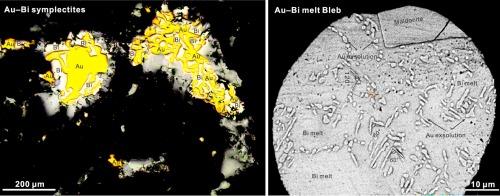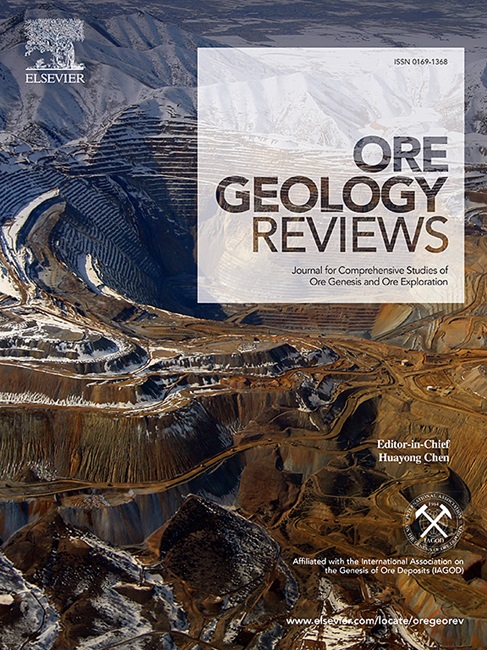Contribution of bismuth melts to gold endowment in the Baolun gold deposit, Hainan Island, South China
IF 3.2
2区 地球科学
Q1 GEOLOGY
引用次数: 0
Abstract
Bismuth (Bi) melts and related polymetallic alloys can efficiently scavenge gold (Au) from Au-unsaturated aqueous solutions, contributing to the Au endowment in many hydrothermal deposits. However, original evidence for Au–Bi melts is often poorly preserved due to post-precipitation alteration. This complicates investigation of the liquid bismuth collector model in hydrothermal Au deposits. Here we present primary evidence for the occurrence of Au–Bi melt in hydrothermal systems through an examination of the Au–Bi phases and textures in the Baolun Au deposit (Hainan Island). This study found that maldonite, native bismuth, Au–Bi symplectite and Au–Bi melt blebs appeared successively following the precipitation of native gold. Notably, large Au–Bi melt blebs were well preserved in natural systems due to the rapid cooling of fluids. The mineral assemblages and their corresponding fluid physiochemical conditions suggest that the evolution of the ore fluids at Baolun was characterized by a continuous reduction in Au and Bi concentrations and Au/Bi ratios alongside decreasing fluid temperatures and sulfur fugacity (fS2). These observations offer direct evidence for Au scavenging by Bi melts in a mesothermal (275–450 °C), low-fS2 and reduced hydrothermal system, aligning well with the Au–Bi binary phase evolution established in metallurgy. As the fluid cooled further, the Au–Bi phases were subsequently overprinted by later Te–S-rich fluids, as evidenced by the formation of bismuthinite, jonassonite, and joséite-A around the Au–Bi phases. Importantly, our study reveals that the Baolun Au deposit is characterized by a Au–Bi–Te hydrothermal system and that the metamorphic country rocks at Baolun are the major source of Au, Bi, and Te.

铋熔体对中国南方海南岛宝轮金矿床金赋存的贡献
铋(Bi)熔体和相关的多金属合金可以有效地从金不饱和水溶液中清除金(Au),从而增加许多热液矿床中的金赋存量。然而,由于沉淀后的蚀变,金铋熔体的原始证据往往保存得很差。这使得对热液金矿床中液态铋收集器模型的研究变得更加复杂。在此,我们通过对宝轮金矿床(海南岛)中的金铋相和纹理的研究,提出了热液系统中出现金铋熔体的原始证据。这项研究发现,在原生金沉淀之后,先后出现了麦饭石、原生铋、金铋共闪石和金铋熔斑。值得注意的是,由于流体的快速冷却,大型金铋熔体斑在自然系统中保存完好。矿物组合及其相应的流体物理化学条件表明,在宝轮矿石流体的演化过程中,随着流体温度和硫富集度(fS2)的降低,金和铋的浓度以及金铋比不断降低。这些观察结果直接证明了在中温(275-450 °C)、低fS2和还原的热液系统中,Bi熔体对金的清除作用,这与冶金学中确立的金铋二元相演化十分吻合。随着流体的进一步冷却,金-铋相随后被后来的富Te-S流体覆盖,在金-铋相周围形成的铋石、黝帘石和黝帘石-A就是证明。重要的是,我们的研究揭示了宝轮金矿床的特点是金-铋-碲热液系统,宝轮的变质岩是金、铋和碲的主要来源。
本文章由计算机程序翻译,如有差异,请以英文原文为准。
求助全文
约1分钟内获得全文
求助全文
来源期刊

Ore Geology Reviews
地学-地质学
CiteScore
6.50
自引率
27.30%
发文量
546
审稿时长
22.9 weeks
期刊介绍:
Ore Geology Reviews aims to familiarize all earth scientists with recent advances in a number of interconnected disciplines related to the study of, and search for, ore deposits. The reviews range from brief to longer contributions, but the journal preferentially publishes manuscripts that fill the niche between the commonly shorter journal articles and the comprehensive book coverages, and thus has a special appeal to many authors and readers.
 求助内容:
求助内容: 应助结果提醒方式:
应助结果提醒方式:


